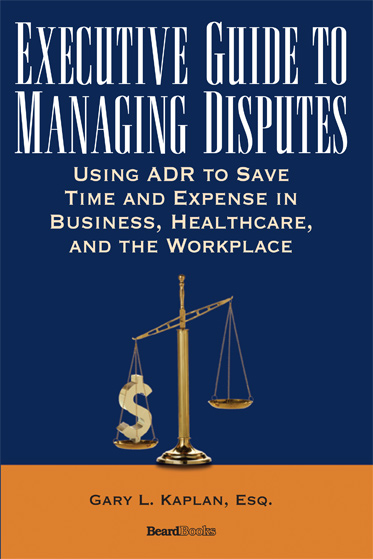 | Executive Guide to Managing Disputes:
Using ADR to Save Time and expense in Business, Healthcare, and the Workplace
By Gary Kaplan 
1587982986 -
$49.95
Publisher
Comments
Drawing upon more than 25 years experience as a business lawyer, arbitrator, and mediator,
Gary Kaplan not only explains why litigation is so costly,
but also how to manage disputes sensibly to avoid unnecessary litigation, reduce costs, and improve results.
The Executive Guide draws from the latest scientific research and economic theory to explain, contrary to popular sentiment,
that the high cost of litigation is systemic, rather than the fault of supposedly greedy lawyers.
Indeed, litigation is a perfect storm of circumstances that leads to bad decisions about when and if to settle business disputes
and why it is such an inefficient process for obtaining decisions and resolving claims.
The Executive Guide shows how ADR (i.e., Alternative Dispute Resolution), such as mediation and arbitration, can short-cut disputes,
and how to use often inexpensive dispute management programs to contain costs and achieve favorable outcomes that focus on cultivating
positive business, workplace, and healthcare relationships.
For More Information CLICK HERE
CLICK HERE to listen to a podcast by the author discussing Alternative Dispute Resolution.

“Kaplan’s Executive Guide unravels the mysteries, complexities, and absurdities of modern litigation and its alternatives with penetrating insight, fine judgment, and common sense.”
—Douglas G. Baird, Harry A. Bigelow Distinguished Service Professor of Law, The University of Chicago Law School
“Provocative and well-written, Gary Kaplan’s book offers lawyers and business executives a new framework for considering and addressing costly disputes. Although litigation is sometimes necessary, the Executive Guide persuasively shows the importance of planning for potential lawsuits and using proven ADR processes to manage and contain their impact.”
—Judith Harris, Esq., Partner, Reed Smith, LLP
“As one who had a strong case, but unrealistic expectations as to time and monetary cost of litigation, I encourage every executive, business owner, and healthcare provider to read Gary Kaplan’s Executive Guide to Managing Disputes. As Mr. Kaplan persuasively explains, the high cost in time and money and uncertainty of litigation makes it a dubious and stressful undertaking, even for the strongest cases. In view of this problem, Gary Kaplan's book, in a sensible and compelling manner, encourages business and healthcare professionals to plan for disputes rather than unrealistically hope that none will arise. By using Gary Kaplan's ADR guide, one can safeguard against costly, time consuming, and wasteful litigation.”
—David Gilliand, President, Geodax Technology, Inc.

 Gary L. Kaplan is attorney with more than 25 years experience in commercial litigation, business transactions, and dispute resolution. Mr. Kaplan serves as an arbitrator and mediator for the American Arbitration Association, the American Health Lawyers Association, the National Arbitration Forum, the CPR Institute and the United States District Court of the Western District of Pennsylvania. Mr. Kaplan received his B.A., summa cum laude, with distinction in economics from Yale University (1980) and his J.D. from the University of Chicago Law School (1983).
Gary L. Kaplan is attorney with more than 25 years experience in commercial litigation, business transactions, and dispute resolution. Mr. Kaplan serves as an arbitrator and mediator for the American Arbitration Association, the American Health Lawyers Association, the National Arbitration Forum, the CPR Institute and the United States District Court of the Western District of Pennsylvania. Mr. Kaplan received his B.A., summa cum laude, with distinction in economics from Yale University (1980) and his J.D. from the University of Chicago Law School (1983).
Mr. Kaplan is a Partner in the Pittsburgh firm of DeForest Koscelnik Yokitis Kaplan & Berardinelli and he teaches as a Professorial Lecturer in Law at The George Washington University Law School in Washington, D.C. From 1991 through 2003, Mr. Kaplan practiced at Reed Smith, LLP, which he joined after serving as the Director of the Trade Remedy Assistance Office of the U.S. International Trade Commission in Washington D.C. and after practicing in Los Angeles with the law firm of O’Melveny & Myers.
Mr. Kaplan's legal practice focuses on information technology (“IT”), intellectual property licensing, e-commerce, antitrust, competition law, and commercial litigation. He is a member of the state bars of Pennsylvania, District of Columbia, California, Ohio, and West Virginia, and he serves as Chairman of the Legislation and Class Actions subcommittee of the American Bar Association's Arbitration Committee.

|
Foreword
|
9
|
|
About the Author
|
11
|
CHAPTER ONE: The Executive’s Guide to Litigation:
What to Expect and Why Even Winners Lose
|
13
|
|
The Anatomy of a Lawsuit |
13 |
|
Investigation and Pleadings |
13
|
| Preliminary Conference and Scheduling |
15 |
| Discovery |
16 |
| Expert Discovery |
19 |
| Pretrial Motions |
20 |
| Trial Preparation |
21 |
| Jury Selection |
22 |
| Trial |
23 |
| Post-Trial and Appeals |
25 |
|
CHAPTER TWO: Chapter II: The Persistence of Irrational Lawsuits |
26 |
| The Honeymoon: In Love with Your Case |
26 |
| Self-Serving Bias: Confusing Fairness with Self-Interest |
27 |
| Confirmation Bias: Seeing What We Want to See |
29 |
| Availability: “What We Don’t Know (or Understand) Can’t Hurt Us” |
33 |
| Attribution Error: Assuming the Worst of the Opposition |
34 |
| Overconfidence, Undue Optimism and Illusions of Control |
34 |
| Conflicting Risk Profiles |
37 |
| Married to Your Case with No Way Out |
38 |
| Conclusion |
40 |
| CHAPTER THREE: The Litigation Problem:
An Inefficient Process for Deciding Disputes |
41 |
| The Characteristics of Efficient Dispute Resolution |
42 |
| Wasteful Redundancy |
44 |
| The Invisible Hand Gone Awry: Incentives That Promote Inefficiency |
45 |
| Passive Decision Makers |
53 |
| Uncertainty as an Impediment to Settlement |
55 |
| Conclusion |
56 |
|
CHAPTER FOUR: An Overview of Dispute Resolution Alternatives |
58 |
| Negotiation Before Litigation |
58 |
| Negotiation During Litigation |
59 |
| Mediation |
60 |
| Arbitration |
63 |
| Dispute Management and Avoidance |
63 |
|
CHAPTER FIVE: Why Mediation Can Often Resolve Disputes
More Effectively than Direct Negotiation |
66 |
| An Economic Model for Settlement of Commercial Disputes | 67 |
| Interest-Based Approaches to Healthcare and Workplace Disputes |
68 |
| Information Risks |
70 |
| Reactive Devaluation |
70 |
| Agency Problems and Intraparty Conflicts |
71 |
| Overcoming Distrust |
73 |
| Reality Checking and Case Valuation |
74 |
| CHAPTER SIX: Arbitration: A Potentially Efficient Alternative | 76 |
| Background |
76 |
| An Overview of Business Arbitration |
77 |
| Efficiency Risks of Arbitration |
79 |
| Efficient Options for Arbitration |
81 |
| Advance Selection of an Efficient Arbitrator |
82 |
| Cost-Saving Procedural Rules |
82 |
| Prohibiting Prehearing Depositions |
83 |
| Prohibit and/or Limit Prehearing Motions |
83 |
| Set Time Limits for Completion of the Arbitration |
84 |
| Conclusion |
84 |
| CHAPTER SEVEN: Models for Efficient Resolution of Business Disputes:
Investigatory Mediation and Arbitration and
Co-Expert Mediation |
85 |
| Investigatory Mediation and Arbitration |
85 |
| Co-Expert Mediation |
90 |
| CHAPTER EIGHT: Dispute Containment and Management of
Project Disputes |
92 |
| Managing Potential Disputes with Effective Contracts |
93 |
| Managing Disputes as They Arise |
93 |
| Management of Project Disputes |
94 |
| CHAPTER NINE:Dispute Management Systems:
Case Studies and Cost Savings |
97 |
| Comprehensive Dispute Management |
98 |
| Commercial and Product Liability Disputes |
104 |
| Workplace Dispute Systems |
107 |
| Healthcare Dispute Systems |
114 |
| Case Study Conclusions |
118 |
| CHAPTER TEN: Development and Implementation of
Dispute Management Systems |
120 |
| Impediments to the Adoption of ADR |
120 |
| Successful Dispute Management and Paradigm Change |
122 |
| Dispute Management Systems for Healthcare and
Business Relationships |
126 |
| Dispute Management Systems for the Workplace |
127 |
| System Design Phase I: Project Requirements and Scope |
129 |
| System Design Phase II: Project Architecture |
131 |
| System Design Phase III: Build Out |
132 |
| System Design Phase IV: Testing, Refinement, and Implementation |
133 |
| System Design Phase V: Monitoring, Assessment, and Improvement |
133 |
| CHAPTER ELEVEN: The Future: Online Dispute Resolution and
Virtual Sessions |
135 |
| Automated Negotiation Systems |
137 |
| Facilitated Negotiation Systems |
138 |
| Online Arbitration |
138 |
| Online Mediation |
139 |
| The Future: ADR in Virtual Worlds |
140 |
| ADR in Virtual Sessions |
144 |
| CHAPTER TWELVE: Conclusion |
148 |
| Works Cited |
150 |
|
